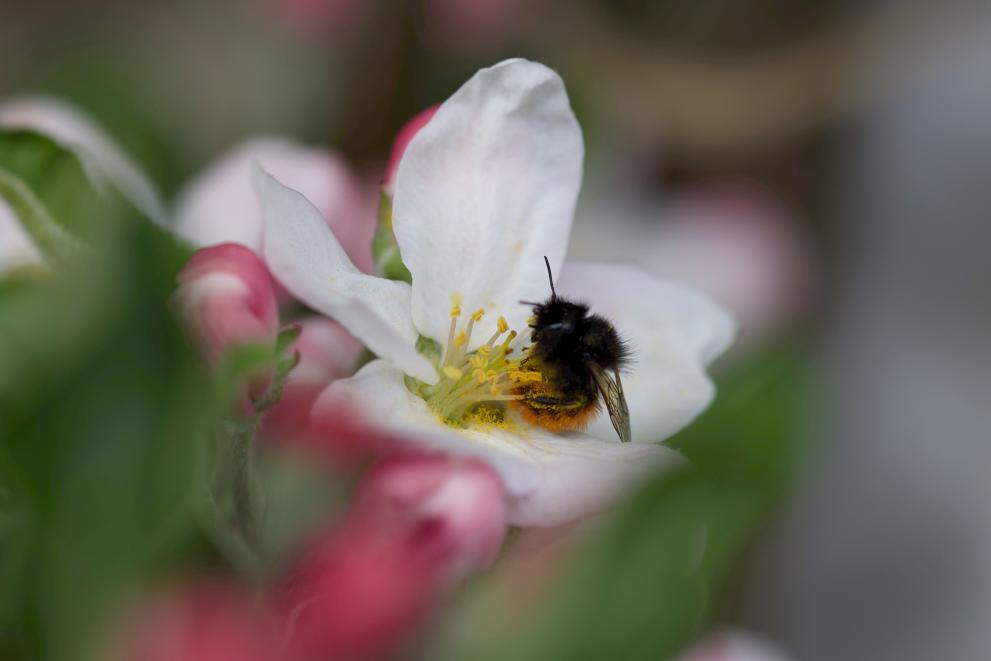
Globally, some 87 billion tons of apples are produced commercially each year, valued at over US $45 billion (€41 bn)1 – making them one of the world’s most economically important crops. Most apples are not self-fertile and rely on insect pollination to produce fruit. Although this agro-ecosystem service can be provided by a broad range of pollinators, commercial growers have largely become reliant on managed colonies of the western honey bee, Apis mellifera, brought into apple orchards during the flowering season.
However, studies increasingly show that relying on a single managed pollinator species for pollination is a risky strategy in the context of climate change. In contrast, some research has found that species richness and diversity of wild bees in the vicinity of orchards is positively associated with apple yield, weight and quality, regardless of honey-bee abundance.
Acknowledging that other factors – for example weather and management practices – are also influential, researchers in this new study sought to further investigate the role of wild bees in a large-scale field study. They sampled nearly 13 000 bees from 46 conventional and organic orchards in Belgium, France, Morocco, the Netherlands, Spain and the UK during the flowering period in 2019, and analysed bee community data for honey-bee dominance, species richness and diversity (e.g. traits and genetic information).
They also recorded landscape characteristics (e.g. urban land cover in the surrounding area), along with climate variables and management practices (such as pesticide use). Producers provided data on their 2019 crop yields, in tons per hectare, and 1 210 apples were sampled from 22 sites. The number of seeds, weight and malformation of apples were recorded as indicators of pollination efficiency and fruit quality.
Overall, the researchers found 173 bee species. Apis mellifera represented 40% of total bees recorded; their relative abundance at sites ranging from 7.5% to 97.1%. The next most common species were bumble bees (Bombus terrestris and B. lucorum), furrow bees (Lasioglossum malachurum), mining bees (Andrena haemorrhoa) and mason bees (Osmia bicornis).
Analysis with modelling software indicated that yield was mainly driven by management practices (e.g. weed control and fertilisation). Organic management was associated with lower yields, possibly due to greater pest and disease damage.
Key findings in relation to pollination were that honey-bee dominance had no significant impact on yield and that higher wild bee species richness was linked to a better apple seed set (number of seeds within fruit), which also influences quality. The researchers suggest that wild bee assemblages (i.e. all species that exist in a particular habitat) have the potential to ensure pollination services, and the way they collect pollen may be advantageous (honey bees are more motivated to collect nectar). Meanwhile, honey-bee dominance was systematically associated with lower wild bee diversity, say the researchers, perhaps due to competition for resources.
To harness wild bee diversity as a nature-based solution to apple pollination, nature-friendly growing practices are important, such as reducing pesticide use, encouraging an abundance of habitats by combining diversified farming systems (as opposed to monocrops) with patches of natural vegetation and wildflowers, and connecting these natural habitat patches to one other through the croplands. The researchers also suggest that honey-bee management should value the quality of bee health over quantity, to reduce levels of Varroa mites, for instance.
Further Information:
- Food and Agriculture Organisation of the United Nations (2020) ‘Crops and livestock products’ www.fao.org. Available from: FAOSTAT [Accessed 29 November 2022].
Source:
Weekers, T., Marshall, L., Leclercq, N., Wood, T.J., Cejas, D., Drepper, B., Garratt, M., Hutchinson, L., Roberts, S., Bosch, J. and Roquer-Beni, L. (2022) Ecological, environmental, and management data indicate apple production is driven by wild bee diversity and management practices. Ecological Indicators, 139: 108880.
To cite this article/service:
“Science for Environment Policy”: European Commission DG Environment News Alert Service, edited by the Science Communication Unit, The University of the West of England, Bristol.
Notes on content:
The contents and views included in Science for Environment Policy are based on independent, peer reviewed research and do not necessarily reflect the position of the European Commission. Please note that this article is a summary of only one study. Other studies may come to other conclusions.
Details
- Publication date
- 7 December 2022
- Author
- Directorate-General for Environment

